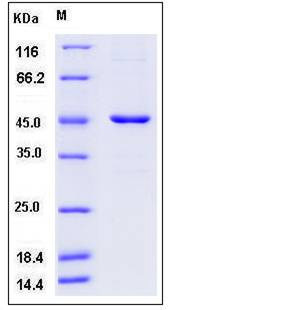Mouse HDAC8 / HDACL1 Protein (His Tag)
2610007D20Rik
- 100ug (NPP3349) Please inquiry
| Catalog Number | P50273-M08B |
|---|---|
| Organism Species | Mouse |
| Host | Baculovirus-Insect Cells |
| Synonyms | 2610007D20Rik |
| Molecular Weight | The recombinant mouse HDAC8 consists of 387 amino acids and has a calculated molecular mass of 43.1 kDa. It migrates as an approximately 46 kDa band in SDS-PAGE under reducing conditions. |
| predicted N | Met 1 |
| SDS-PAGE |  |
| Purity | > 90 % as determined by SDS-PAGE |
| Protein Construction | A DNA sequence encoding the mouse HDAC8 isoform 1 (Q8VH37-1) (Met 1-Val 377) was expressed,with a C-terminal polyhistidine tag. |
| Bio-activity | |
| Research Area | Immunology |Signal Transduction |Transcription Factors and Regulators |Transcriptional Co-Repressors |
| Formulation | Lyophilized from sterile 20mM Tris, 500mM NaCl, pH 7.4, 10% gly 1. Normally 5 % - 8 % trehalose and mannitol are added as protectants before lyophilization. Specific concentrations are included in the hardcopy of COA. |
| Background | Histone deacetylase 8, also known as HDAC8 and HDACL1, is a nucleus and cytoplasm protein which belongs to the histone deacetylase family and HD type 1 subfamily. Histone deacetylases (HDACs) are a growing family of enzymes implicated in transcriptional regulation by affecting the acetylation state of core histones in the nucleus of cells. HDAC8 / HDACL1 is weakly expressed in most tissues. It expressed at higher level in heart, brain, kidney and pancreas and also in liver, lung, placenta, prostate and kidney. HDAC8 / HDACL1 is responsible for the deacetylation of lysine residues on the N-terminal part of the core histones ( H2A, H2B, H3 and H4 ). Histone deacetylation gives a tag for epigenetic repression and plays an important role in transcriptional regulation, cell cycle progression and developmental events. Histone deacetylases act via the formation of large multiprotein complexes. HDAC8 / HDACL1 may play a role in smooth muscle cell contractility. HDAC8 / HDACL1 may be a potential drug target for neuroblastoma differentiation therapy using selective inhibitors, avoiding unspecific side effects. |
| Reference |
